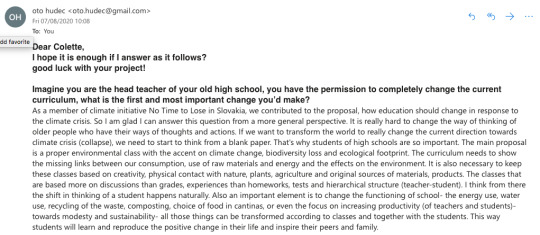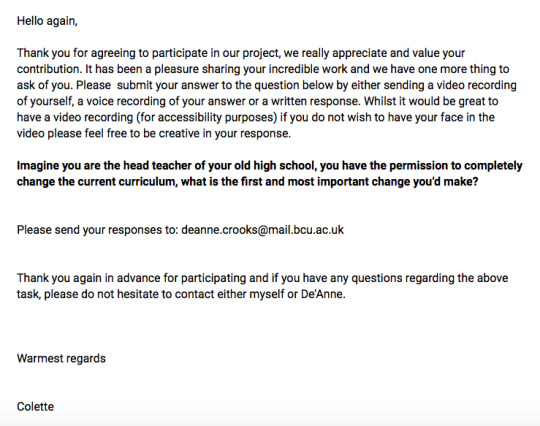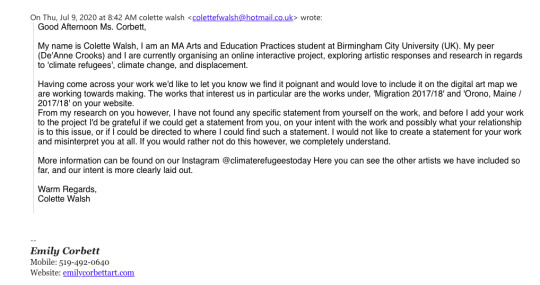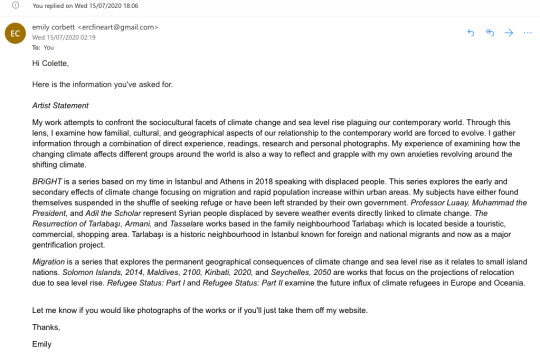Text
Reflections
Back in November 2019 the prospect of putting on a workshop at Tate Liverpool was something I had not imagined myself doing even months prior. Accepting the invite to do a workshop really came before the idea itself. This was a chance to work with De’Anne as well, which was an obvious big yes from me. Because of the theme of climate change in Mikael’s exhibition we would be responding to, I suggested incorporating something to do with climate refugees into our work. I could see links to this issue with the work De’Anne and myself already engage with; the social problems that come about when a group of people are othered and preferring the voices of those not often listened to, rather than the mainstream expectations of what is normally given a platform. I must admit I’ve been ignorant to most things climate change, the science alienated me, it felt like a far off issue that existed in Sci-Fi films and the best I could do was recycle and cut down on my meat consumption. I was first introduced to the plight of the climate ‘refugee’ through a friend who had held a charity event a couple of years ago. I was taught what these people were going through, but again these people seemed really distant to my reality. That feels very ignorant to type out, but that is the reality of most charitable causes we are told to stop and listen about every so often. Once De’Anne and I had picked this idea I went back to my friend to find out more. I learnt that the climate refugee doesn’t originate from one specific island or country – people are rapidly having to migrate due to climate change all over the world. This obviously didn’t make the daunting subject matter any more manageable – but I guess it was very selfish of me to be disturbed by the scope of the issue, rather than the reality of the issue itself.
We put this project on the backburner for a while, Narratives was at the forefront of our minds. Then COVID19 hit. Well it didn’t hit from nowhere, we had had warning signs from overseas, watching our European neighbourhood slowly descent into lockdown, but eventually the same happened in Birmingham. One day we were in class, and the next the building was shut. Again, Global Innovations didn’t play much of a part of our conversations for a while. We were stressed out about having to, what felt like, compromise our direction with Narratives. Overnight we all became digital artists, having extensive conversations about this new sphere we had actually been a part of for many years, but now had to actively engage with; the internet. The changes we made with Narratives hardened us however to the bootstraps we would have to pull up when we realised the entire project that was supposed to be in a gallery space, engaging with real life people, would actually be online. To incorporate real life people online seems impossible, even though most of the people online are realto a certain extent. I don’t know what the turning point was, but we eventually realised a project that wanted to be a part of the global community should have the endless space and communication of the internet, rather than being literally boxed into a room and an hour or so long slot. Because we hadn’t planned too much of the project ( we just knew we wanted to engage with people who have a more immediate connection with the issue) we didn’t have to changemuch, rather we built on this little idea we had kept in the back of our minds. We had originally been considering the possibility of inviting people into the gallery – people we were unable to pay, who may be from a vulnerable group: would this have been exploitative? Now we had the pressure off of these factors, and (arguably) millions of artists at our fingertips.
We began researching. From the very beginning really. Teaching ourselves about climate change and climate induced migrancy from the very start. Quite naïvely we collated our facts and figures. Every website said something different. I put up a couple of posts on the Instagram page about figures of refugees and definitions of words, but they felt reductive. My simplified regurgitation of what I had learnt wasn’t helping anyone, and if it was it was just solidifying basic facts that could easily be googled. We had a meeting that felt like a sigh of relief when we admitted to each other we weren’t getting very far with this approach. We had a basic understanding of the causes of climate change, the effects on communities all over the world, and some of the struggles they face. We needed to step out of this googling spiral. The next step was to look for artists who could help us to understand what we were learning more. These artists ranged from people directly affected by climate change, such as Sarabel Santos who has created photography installations studying the effects of Hurricane Maria in Puerto Rico, artists who are descendent from areas affected, like Rejin Leys, a Haitian print maker living in New York, or artists who have decided to dedicate their work to these issues, and don’t necessarily have such a strong personal connection with climate migrancy, much like Hermann Josef Hack, the creator of the WORLDWIDE BRAINSTORM PROJECT.
My approach was to research the artists, get an idea of what they were about, get in contact with them and present their work on the Instagram. I feel as though I allowed the work and the artists to speak for themselves. An overview of the page I think reflects how diverse the population of climate refugees and those working with them is. Our initial approach was going to be to email the artists. We soon found that from posting their work on the Instagram they would normally follow us back. A lot of the conversations I had with the artists were over Instagram DM. The template we used to speak to them was pretty much the same throughout, and in hindsight I feel as though after the initial interaction the format of our conversations could have been a little less formal.
This lack of formality however could be attributed to some of the downfalls of the project. Artists who at first seemed fully invested, especially when we were praising their work and sharing it, sometimes fell short on their enthusiasm to collaborate when we got to the stage of approaching that part of the project. With no real obligation to Climate Refugees Today the flippancy of Instagram DMs allowed for correspondence to suddenly stop. Perhaps had we introduced the collaborative task (requesting a response to our question, whether that be a video, voice note or short written piece) at the start of the correspondence, we would have maintained the enthusiasm and momentum. This however was not possible in this instance because myself and De’Anne really were taking every step as it came. Having to slowly learn about the topic itself and approaching each week by just having a conversation about the progress, we weren’t to know what exactly the collaborative element with the artists was going to be. I feel as though this project would have been impossible to pre plan completely, because the organic growth of our understanding of the topic dictated the outcome. I believe had we been in contact with a different load of artists the outcome would be completely different from how it is now, because we learnt valuable lessons and approaches from all of them. My entire blog just seems to be recording chats I’ve been having. Did lockdown make these conversations turn into something they originally would not have been? The scarcity of contact whilst collaborating with someone I would normally see a couple times a week put these chats on a pedestal. All I have is conversations. The Instagram has been an edited regurgitation of conversations I’ve been having. The power of dialogue when you’re learning and teaching. It’s a process of absorbing information – but does it really mean anything if you don’t talk with people? If a tree falls in the forest…
Does the educator have to be competent to teach? This is a question that has come up in the work, and I feel as though the execution of this project has been an experiment into finding this out. What started as a project that aimed to educate on the issue of climate refugees has become an exercise of me facilitating a space that exemplifies the impact artists are able to make on a global platform. What is my role in this project? Am I educating anyone? At the moment I feel as though the Instagram itself is perhaps not the educating tool, but rather a documentation of my own education in this field. You can clearly see the progress in understanding this issue mapped out in the tiles on the account. And each tile opens a page to an artist or project that has their own approach to educating – whether their work means to be educational or not, surely work surrounding a subject one might not know much about is educational in some aspect. It’s a rabbit hole of information, not strictly on the initial subject we intended. I hope people who engage with both the Instagram and the final map not only learns something about the plight of climate migrants and the climate emergency, but also perhaps learns how to take Ley’s or Santos’ approach to their own work and apply it to something they are passionate about. Although all the artists we spoke with are linked into the same global issue, they are also engaging in how to represent narratives that encompass entire communities – something that is integral today as we see and take part in so many counter political movements coming into the mainstream.
During my BA we discussed ‘decolonising’ the history of art, and I never really understood how that would look, because the vantage point I’ve always understood and been exposed to has been Western. I did a few modules on Japanese art and ‘Primitivism’, but even then I was reading texts mostly written by Western writers, from a detached place. Obviously a language barrier existed in these situations, along with my acceptance of taking someone else’s first hand research and regurgitation of this as the only way I would be able to access this knowledge. Throughout the project I have been super aware of trying to shake this western perspective, to the point where I have questioned whether I should even be pursuing this area of knowledge. How can I approach these issues that doesn’t involve some kind of voyeurism or white saviour complex? First of all, I had to drop any notion that the project was in any way some kind of activism. The thought of this all being an attempt at activism weighed down on my motivations to carry on. I am not trying to save the world, save the climate refugees, or fix the planet – I want to facilitate a space where people can discuss these issues. Can this resource be used as a more democratic approach to an issue that is often dictated by Westerners claiming to be the only expert in any field? I’m sure we have probably made some mistakes along the way – some people don’t appreciate the term ‘climate refugees’, preferring ‘climate migrants’ whilst other people think this sums up their experience very well.
Once we freed ourselves of the facts and figures that changed from one web page to the next and started listening to international artists we felt more comfortable that the project was actually working towards the aims we were trying to achieve. Visually with the map, after a conversation with Cathy we decided to go with the authagraphic map, rather than the mainstream traditionally Western domineering version. I can only speak for myself, and I’m sure De’Anne as she created the visual for the map will have something more to say, but I feel like looking at the map expresses how I’ve felt about our aims to de-westernise our approach. At first the map is quite hard to decipher, and it’s completely disconnected from what I am used to – it just takes time and concentration, and finally the pieces start coming together. A major challenge with the project has been letting go of my own perspective and attempting to in whatever way I can take on another’s – and in this case multiple.
The biggest chunk of time spent on this project has most definitely been on researching and communicating with artists. As mentioned previously, the blog does just seem to be a record of conversations, including ones I’ve had with myself. After an overview of all the conversations and ideas we’ve pulled out De’Anne and I had to decide what we were going to request from the artists involved.
Imagine you are the head teacher of your old high school, you have the permission to completely change the current curriculum, what is the first and most important change you’d make?
We landed on this topic for them to discuss because although the ClimateRefugeesToday is centred around one issue, from communicating with the artists involved it’s striking how this one issue can be connected to not only every corner of the world, but most facets of life. To open the question up to the artists to think about the curriculum more broadly really brought out the scope of their work. It also fit in with our prerogative of considering the project to be an experiment in how art education can be used, with the implementation of Instagram and the visual of the map, to consider it within a school setting felt like the cherry on the top. It really made us think; what would the world look like if all educators were artists. Personally, I became so engaged and more understanding of the climate crisis once I came into contact with the visual arts, what impact would that have on school kids and future generations looking after the planet? This project has made me want to explore the idea of the impact of art on the more ‘traditional’ subjects, in the same way our project has approached not only a political matter, but a scientific and social geographical issue, without reeling off quotes from ‘experts’.
0 notes
Photo

This is the latest version of the map De’Anne has sent me. So we are on track! I just received a message from Sarabel Santos in Puerto Rico telling us they should have their video done by Sunday.
0 notes
Photo





Graphics I created using Lisbon based artist Oto Hudec’s work and words to illustrate his response. This has been featured on the instagram and will be used on the final map.
0 notes
Video
Hermann Josef Hack, a Berlin based artist, talking about the importance of connectivity and awareness - this response seems to be closely linked to his GLOBAL BRAINSTORM PROJECT - which will be celebrating it’s 30th year running next year.
0 notes
Video
Jaz an artist based in Birmingham talking about the importance of technology and accessibility to the continuously changing landscape of communication and work
0 notes
Video
Lilli Whitham, an artist from Birmingham’s submission, talking about the importance of politicising the school environment to nurture conscientious students, rather than shying away from politics and creating indifference.
0 notes
Photo

After this conversation I wondered if the question we had set was too specific, or maybe even too vague. Unfortunately Leys wasn't able to participate, which was really such a shame because they were the first artist we had been in contact with, featured on the page and had been messaging quite regularly with.
This brings up questions for me around the role of social media in this project. At first it was amazing we had all these artists at our finger tips, and although a lot of them may have ignored even our initial messages, we were able to all of a sudden be in contact with people working New York or South American. Does the fact there is not as much of a formal barrier between people when corresponding in turn mean there is a lack of obligation to fulfil promises.
Ofcourse I don't want to load all of this speculation onto Leys who has their own life and circumstances - but this interaction definitely demonstrated it’s not as easy as DMing someone and completing a project.
De’Anne and myself have also found it quite awkward to chase up submissions that we were told we were going to get, but then seem to have been forgotten about. Some participants recorded the video and sent it off straight away, but others have had to be messaged a couple of times. How do you balance the line of not wanting to nag people yet having a deadline?
0 notes
Text
The Problem With Social Media
We seem to have entered the final stage of the project, the execution of the map and the tying of all loose ends.
Now that it’s over to De’Anne to really pull things together and do the technical process of creating the map, we really are on a deadline to get the submissions in. This is where the magic of people replying to DMs and emails during lockdown suddenly has failed.
Unfortunately a few artists we had been corresponding with, who seemed so supportive of the work ignored our messages once we requested the submission. It’s understandable that people are busy, especially when life in the UK has seemed to pick up all of a sudden. But when someone you have been speaking to about a project that has so much potential, and sharing their work on social media, suddenly loses interest in what you’ve been discussing for the past 6 weeks it’s difficult to take it lightly. I understand we aren’t paying anyone to do anything, but the task we set was purposefully designed to be simple and quick to complete. This element has been a learning curve in regards to pursuing a project. The face we reached out of LOADS of people really saved our arses when only a couple have lasted to the end. The people who lasted to the end - I’m so grateful to.
Due to a lot of the ‘global’ artists not managing to take part in the final map (in an interactive sense - their work is still really important and I can’t discredit how vital their presence on the map is) we decided to open it up to artists we know personally. These people, our friends, for the most part were already following what we were doing on instagram, so I’d like to think they had an idea of what we were trying to achieve. Fortunately, from relying on these people we’ve managed to get a good couple of responses. As I am writing this we have 2 videos from people we are friends with, 1 from an artist based in Berlin found on the internet, a written response from an artist in Lisbon, and the prospect of another submission coming from an artist based in Puerto Rico.
0 notes
Text
Tutorial with Cathy
After my meeting with De’Anne I had a short tutorial with Cathy. We discussed some reflections that I’d like to make on the project, looking more in depth at the role Instagram has played, how COVID has had an effect on communication world wide, especially with artists, breaking down the formality that normally dictates these interactions.
a theme that seems to be a part of a lot of what I do is thinking about how learning and education can take place outside of a traditional school setting.
what does having a lifelong education mean?
when do we stop learning? Do we ever stop learning?
Does art have a unique quality that lends itself to constantly being accessible to people of all ages, worldwide? The appropriation of imagery that can take on meanings that tell stories of family histories, or the current reality of the global community.
0 notes
Text
Imagine you are the head teacher of your old high school, you have the permission to completely change the current curriculum, what is the first and most important change you’d make?
I had a meeting with De’Anne yesterday.
We decided on how we were going to approach the collaborative side of the project with the artists who had been in touch. I feel like this question or request steers the participants to discussing the ideas we have been reflecting with this project, without being really obvious or cliche. I always think hypothetical questions work better when asking someone to be imaginative on a topic that they don’t necessarily connect with as much as you do.
We discussed the difference between activism and education, and how we don’t want our project to be perceived as activism - mainly because I don't think it would pass as strong activism. Just because we are engaging with a cause that is calling for the global community to help - doesn’t mean we are actively being activists. I’m not educated enough in this sphere to do any meaningful activism and this process has been about educating myself and in turn looking to others to create a mode of education through art.
what would the world look like if every educator was an artist?
We also discussed the aesthetic side of the map. This is where De’Anne will play a more primary role. We discussed using colours that kind of match up with the colours I’ve been using on the Instagram. So I am looking forward to the outcome!
0 notes
Photo


Oto Hudec, Tartaruga I., Tartaruga II' (2017)
'A pair of giant turtles carrying clay models of houses on their backs were suspended in the gallery space for Slovak artist Oto Hudec’s Archipelago exhibition at the Bratislava House of Arts in 2017. They formed the striking centrepiece of a show that brought together two years of artistic engagement with the inhabitants of a village in the Cabo Verde islands and migrants from the former Portuguese colony living in the Cova da Moura neighbourhood of Lisbon. Working with these geographically remote but culturally connected communities through ceramic workshops, photography and documentary film, the artist uncovered the entanglements of home and migration, legacies of colonial exploitation and Anthropocene tales of drought, failed harvests and rising ecological anxiety. The hanging sculptures recall the non-Western and indigenous my theme of the World Turtle that supports the living world and the oceanic migrations undertaken by an allegedly sedentary species.' (Maja and Reuben Fowkes)
0 notes
Photo


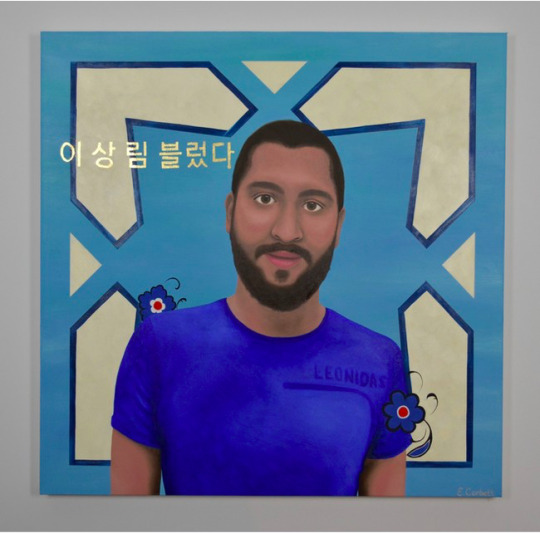
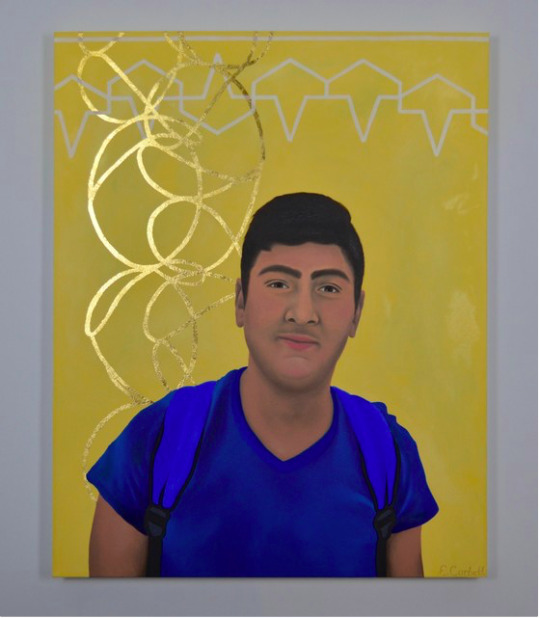

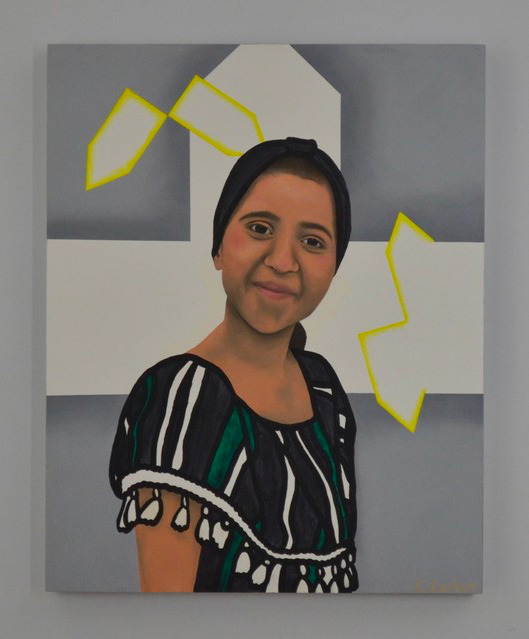
Emily Corbett, "BRiGHT" Series (2018-2019)
Artist's statement:
'BRiGHT is a series based on my time in Istanbul and Athens in 2018 speaking with displaced people. This series explores the early and secondary effects of climate change focusing on migration and rapid population increase within urban areas. My subjects have either found themselves suspended in the shuffle of seeking refuge or have been left stranded by their own government. Professor Luaay, Muhammad the President, and Adil the Scholar represent Syrian people displaced by severe weather events directly linked to climate change. The Resurrection of Tarlabaşı, Armani, and Tasselare works based in the family neighbourhood Tarlabaşı which is located beside a touristic, commercial, shopping area. Tarlabaşı is a historic neighbourhood in Istanbul known for foreign and national migrants and now as a major gentrification project. '
‘The Resurrection of Tarlabaşı', oil, gold leaf, and fibre on canvas, 30"x46" (2019-2020)
Professor Luaay', oil and gold/silver leaf on canvas, 30"x30" (2018) 'Muhammad the President', oil and gold leaf on canvas 30"x30", (2018)
'Adil the Scholar', oil and gold leaf on canvas 24"x30", (2018)
'Armani', oil on panel, 18"x24" (2019)
'Tassel', oil on panel, 16"x20" (2019)
0 notes
Photo


Rejin is really supportive of the project and I am looking forward to having a look through their suggestions
0 notes
